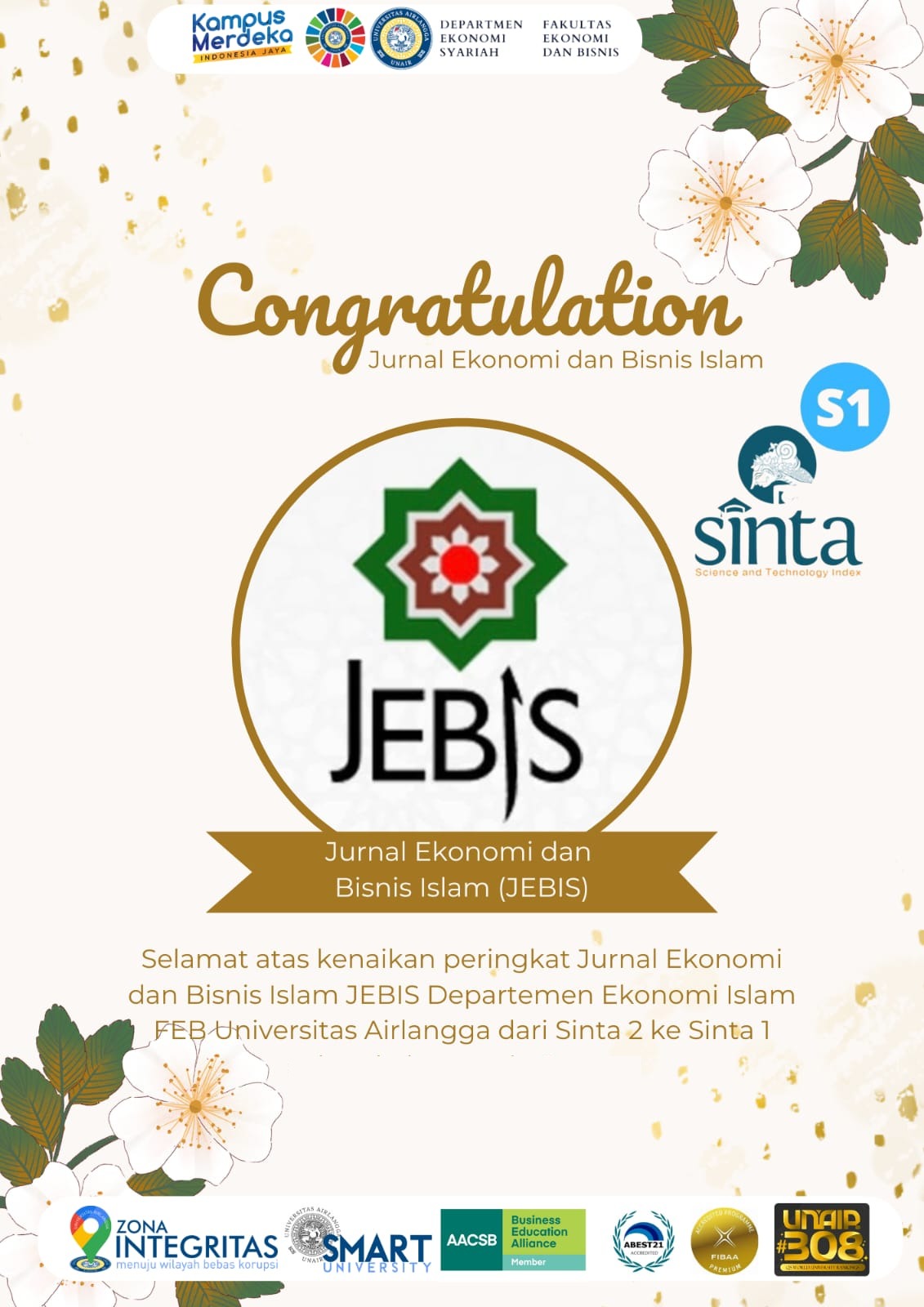ANALYSIS OF FACTORS AFFECTING CUSTOMER SATISFACTION AND CUSTOMER RETENTION ON E-COMMERCE
Downloads
This study aims to analyze the factors that influence consumer retention on the e-commerce website Hijup. This study uses website quality, brand image, and Islamic physical attributes as factors that will shape customer satisfaction which in turn will affect customer retention. This research is quantitative research using two types of data, namely primary data and secondary data. Primary data is obtained by distributing online questionnaires through social media, and secondary data is obtained from books, journals, papers, websites, etc. The number of respondents used in this study were 185 respondents from Hijup consumers who had bought online more than once. This study uses the type of SEM-PLS analysis with SMARTPLS 3.0 software tools. This study shows that website quality and brand image affect customer satisfaction. Moreover, customer satisfaction is able to moderate website quality and brand image on customer retention on the Hijup website, but Islamic physical attributes have a negative relationship with customer satisfaction.
Ajzen, I., & Fishbein, M. (1980). Understanding attitudes and predicting social behaviour. Pretince Hall. http://www.citeulike.org/group/38/article/235626
Amirahmadi, M., Raeisi, D., & Bavar, F. (2015). An Examination of the Effect ofWebsite Quality on Satisfaction and Customer Retention; the Case of Iranian Online BookStores. GMP Review, 16.
Andry, J. F. (2016). THE E-COMMERCE POTENTIAL FOR HOME-BASED BUSINESSES: A CASE STUDY. Jurnal Ilmiah FIFO, 8(2), 139–146.
Anwar, S., Min, L., & Dastagir, G. (2019). Effect of Service Quality, Brand Image, Perceived Value on Customer Satisfaction and Loyalty in the Chinese Banking Industry. International Journal of Business Economics and Management Works, 6(3), 24–30. http://www.ijbemw.com/paper/effect-of-service-quality-brand-image-perceived-value-on-customer-satisfaction-and-loyalty-in-the-chinese-banking-industry
Bakar, A., & Mudiantono, M. (2010). ANALISIS PENGARUH CUSTOMER SATISFACTION, SWITCHING COST, DAN TRUST IN BRAND TERHADAP CUSTOMER RETENTION (Studi Kasus: Produk Kartu Seluler Prabayar simPATI Wilayah Semarang) [University of Diponegoro]. http://eprints.undip.ac.id/24455/
Barnes, S. J., Diaz, M., & Arnaboldi, M. (2021). Understanding panic buying during COVID-19: A text analytics approach. Expert Systems with Applications, 169. https://doi.org/10.1016/j.eswa.2020.114360
Barnes, S., & Vidgen, R. (2000). WebQual: An Ecploration of Website Quality. ECIS 2000 Proceedings. https://aisel.aisnet.org/ecis2000/74/
Battour, M., Ismail, M. N., & Battor, M. (2010). The Impact of Destination Attributes on Muslim Tourist's Choice. International Journal of Tourism Research, 13(6), 527–540. https://doi.org/10.1002/jtr.824
Chen, C.-M., & Liu, H.-M. (2017). The moderating effect of competitive status on the relationship between customer satisfaction and retention. Total Quality Management & Business Excellence, 30(7–8), 721–744. https://doi.org/10.1080/14783363.2017.1333413
Chikako, T. U., & Hamu, G. T. (2021). Assessment of Customers' Relationship Management Practices on Customer Retention and Loyalty of Oromia Credit and Saving Share Company: Bule Hora City Branch. Advances in Operations Research, 2021, 5545836. https://doi.org/10.1155/2021/5545836
Daneshfar, Z., Roshani, A., & Sabzali, H. (2016). Evaluating the Customer Retention and Satisfaction and the Reasons of Losing Customers in the Auto Insurance (A case study). Proceedings of the 2016 International Conference on Industrial Engineering and Operations Management.
Egan, J. (2014). Marketing Communications. SAGE.
Eid, R., & El-Gohary, H. (2014). Integrating Muslim Customer Perceived Value, Islamic Religiosity and Muslim Customer Satisfaction in Tourism Industry. British Academy of Management.
Farias, S. A. de, Aguiar, E. C., & Melo, F. Vi. S. (2014). Store Atmospherics and Experiential Marketing: A Conceptual Framework and Research Propositions for An Extraordinary Customer Experience. International Business Research, 7(2), 87–99.
Fariz, M. (2018). Pengaruh Islamic Store Attributes terhadap Patronage Behavior melalui Costumer Satisfaction pada Islamic Based Store. Jurnal Ekonomi, 9(1), 48–57.
Fauzi, W. I. M., Muhammad, N., Mokhtar, S. S. M., & Yusoff, R. Z. (2016). What Motivate Muslim Consumer to Patronage Islamic Based–retail Store? International Review of Management and Marketing, 6(S7), 199–203. https://dergipark.org.tr/en/download/article-file/367351
Gallo, A. (2014). The Value of Keeping the Right Customers. Harvard Business Review, 29.
Gardiner, S., King, C., & Grace, D. (2012). Travel Decision Making: An Empirical Examination of Generational Values, Attitudes, and Intentions. Journal of Travel Research, 52(3), 310–324. https://doi.org/10.1177/0047287512467699
Global Religious Futures. (2018). Indonesia, Negara dengan Penduduk Muslim Terbesar Dunia. Databooks. https://databoks.katadata.co.id/datapublish/2019/09/25/indonesia-negara-dengan-penduduk-muslim-terbesar-dunia
González-Benito, í“., Muñoz-Gallego, P. A., & Kopalle, P. K. (2005). Asymmetric competition in retail store formats: Evaluating inter- and intra-format spatial effects. Journal of Retailing, 81(1), 59–73. https://doi.org/10.1016/j.jretai.2005.01.004
Groeppel-Klein, A. (2005). Arousal and consumer in-store behavior. Brain Research Bulletin, 67(5), 428–437. https://doi.org/10.1016/j.brainresbull.2005.06.012
Hair, J. F., Black, W. C., Babin, B. J., Anderson, R. E., & Tatham, R. (2006). Multivariate data analysis. Uppersaddle River. NJ: Pearson Prentice Hall.
Hansopaheluwakan, S. (2021). Analysis of e-service quality and website quality effect on e-customer loyalty through e-customer satisfaction (case study: Tokopedia). IOP Conference Series: Earth and Environmental Science, 794(1), 12086. https://doi.org/10.1088/1755-1315/794/1/012086
Hasanov, J., & Khalid, H. (2015). The Impact of Website Quality on Online Purchase Intention of Organic Food in Malaysia: A WebQual Model Approach. Procedia Computer Science, 72, 382–389. https://doi.org/10.1016/j.procs.2015.12.153
Hashim, H., Hussin, S. R., & Zainal, N. N. (2014). Exploring Islamic Retailer Store Attributes from Consumers Perspectives: An Empirical Investigation. International Journal of Economics and Management, 8, 117–136.
Hsieh, S. W., Lu, C. C., & Lu, Y. H. (2018). A Study on the Relationship Among Brand Image, Service Quality, Customer Satisfaction, and Customer Loyalty – Taking ‘the Bao Wei Zhen Catering Team' As an Empirical Study. KnE Social Sciences, 3(10). https://doi.org/10.18502/kss.v3i10.3512
Huang, P.-L. (2019). The influence of service quality on customer satisfaction and loyalty in B2B technology service industry. Total Quality Management & Business Excellence, 30(13–14), 1449–1465. https://doi.org/10.1080/14783363.2017.1372184
Johnston, R. (2004). Towards a better understanding of service excellence. Managing Service Quality: An International Journal, 14(2/3), 129–133. https://doi.org/10.1108/09604520410528554
Kotler, P., Kartajaya, H., & Setiawan, I. (2017). Marketing 4.0: Moving from Traditional to Digital. John Wiley & Sons.
Kotler, P., & Keller, K. L. (2016). Marketing Management (15th ed.). Pearson education.
Lee, C., & Lim, S. (2020). Impact of Environmental Concern on Image of Internal GSCM Practices and Consumer Purchasing Behavior. The Journal of Asian Finance, Economics and Business, 7(6), 241–254. https://doi.org/10.13106/jafeb.2020.vol7.no6.241
Malik, M. E., Ghafoor, M. M., & Iqbal, H. K. (2012). Impact of Brand Image, Service Quality and price on customer satisfaction in Pakistan Telecommunication sector. International Journal of Business and Social Science, 3(23), 123–129.
Mathew, J. (2021). Drivers of Customer Retention: An Introspection Into Indian Retail Customers. Vision: The Journal of Business Perspective. https://doi.org/10.1177/09722629211043592
Maulana, R. R., & Sunaryo, S. (2018). THE INFLUENCE OF BRAND IMAGE ON CUSTOMER SATISFACTION AND CUSTOMER LOYALTY (A Study at Padang Murah Restaurant in Malang City). Jurnal Ilmiah Mahasiswa FEB UB.
McDaniel, S. W., & Burnett, J. J. (1990). Consumer religiosity and retail store evaluative criteria. Journal of the Academy of Marketing Science, 18, 101–112. https://link.springer.com/article/10.1007/BF02726426
Mohammad, A. F., & Raeisi, D. (2002). An Examination of The Effect of Website Quality on Satisfaction and Customer Retention.
Napitupulu, D. (2017). Analysis of Factors Affecting the Website Quality Based on Webqual Approach (Study Case: XYZ University). International Journal on Advanced Science Engineering Information Technology, 7(3).
Neupane, R. (2015). The Effects of Brand Image on Customer Satisfaction and Loyalty Intention in Retail Super Market Chain UK. International Journal of Social Sciences and Management, 2(1), 9–26. https://doi.org/10.3126/ijssm.v2i1.11814
Nguyen, H. T., Nguyen, H., Nguyen, N. D., & Phan, A. C. (2018). Determinants of Customer Satisfaction and Loyalty in Vietnamese Life-Insurance Setting. Economic and Business Aspects of Sustainability, 10(4), 1151. https://doi.org/10.3390/su10041151
Oliver, R. L. (1997). Satisfaction: A behavioral perspective on the consumer. Irwin-McGraw Hill.
Park, H., & Park, S. (2019). The Effect of Emotional Image on Customer Attitude. The Journal of Asian Finance, Economics and Business, 6(3), 259–268. https://doi.org/10.13106/jafeb.2019.vol6.no3.259
Pradana, M. (2015). Klasifikasi Bisnis E-Commerce di Indonesia. Modus, 27(2), 163–174.
Pradana, M., & Puspitasari, D. N. (2016). Webqual Analysis Of Telkom University's Openlibrary System From The Perspectives Of Communication And Business Students. BAndung Creative Movement (BCM), 3(1). https://openlibrarypublications.telkomuniversity.ac.id/index.php/bcm/article/view/5827
Priansa, J. (2017). Perilaku Konsumen dalam Persaingan Bisnis Kontemporer. Alfabeta.
Rahayu, Y. S. (2018). The Role of Religiosity on The Influence of Muslim Customer Perceived Value To Customer Satisfaction of Islamic Banking. International Journal of Education and Curriculum Application. https://doi.org/10.31764/ijeca.v0i0.2005
Rahi, S., & Ghani, M. A. (2016). Internet Banking, Customer Perceived Value and Loyalty: The Role of Switching Costs. Journal of Accounting & Marketing, 5(4), 1–7. https://doi.org/10.4172/2168-9601.1000188
Rahi, S., Ghani, M. A., & Ngah, A. H. (2020). Factors propelling the adoption of internet banking: the role of e-customer service, website design, brand image and customer satisfaction. International Journal of Business Information Systems, 33(4), 549–569. https://www.inderscienceonline.com/doi/abs/10.1504/IJBIS.2020.105870
Ringle, C. M., Wende, S., & Becker, J.-M. (2015). SmartPLS 3.
Roy, G., Datta, B., & Basu, R. (2017). Effect of eWOM Valence on Online Retail Sales. Global Business Review, 18(1), 198–209. https://doi.org/10.1177/0972150916666966
Septiani, A. (2016). Perilaku Konsumen di Era Internet: Implikasinya pada Strategi Pemasaran. UIN Jakarta.
Sheth, J. (2020). Impact of Covid-19 on consumer behavior: Will the old habits return or die? Journal of Business Research, 117, 280–283. https://doi.org/10.1016/j.jbusres.2020.05.059
Shin, J. I., Chung, K. H., Oh, J. S., & Lee, C. W. (2013). The effect of site quality on repurchase intention in Internet shopping through mediating variables: The case of university students in South Korea. International Journal of Information Management, 33(3), 453–463. https://doi.org/10.1016/j.ijinfomgt.2013.02.003
Siagian, H., & Cahyono, E. (2014). Analisis Website Quality, Trust, dan Loyalty Pelanggan Online Shop. Jurnal Manajemen Pemasaran, 8(2). https://doi.org/10.9744/pemasaran.8.2.55-61
Soars, B. (2009). Driving sales through shoppers' sense of sound, sight, smell and touch. International Journal of Retail & Distribution Management, 37(3), 286–298. https://doi.org/10.1108/09590550910941535
Sobari, N., Kurniati, A., & Usman, H. (2019). The influence of Islamic attributes and religious commitments toward halal wellness services customer satisfaction and loyalty. Journal of Islamic Marketing. https://doi.org/10.1108/JIMA-11-2018-0221
Suryani, T. (2013). Perilaku Konsumen di Era Internet: Implikasinya pada Strategi Pemasaran. Graha Ilmu.
Tariq, A., Afzal, A., & Fiaz, M. (2016). The Impact of Consumer Confidence and Store Attributes on Store Satisfaction and Store Loyalty. Journal of Accounting & Marketing, 5(4), 1–6. https://doi.org/10.4172/2168-9601.1000200
Usman, H. (2015). Hubungan Religiusitas dan Pemilihan Bank Islam dengan Memperhitungkan Peran Norma Religius, Trust, Importance of Bank Attributes dan Sumber Informasi. Universitas Indonesia.
Wang, W.-H., Liang, C.-J., & Joonas, K. (2009). Customer Relationship Investments, Value to the Customer, and Value to the Firm: Integrating Attributes and Benefits. Southwest Business and Economics Journal, 23–46.
Wijanto, S. H. (2015). Metode Penelitian Menggunakan Structural Equation Modelling dengan LISREL 9 (1st ed.). Lembaga Penerbit Fakultas Ekonomi Universitas Indonesia.
Yustine, Y., & Fadillah, A. (2015). Pengaruh Customer Satisfaction dan Trust in A Brand terhadap Customer Retention (Studi Kasus Pengguna Produk XL pada Mahasiswa STIE Kesatuan). STIE Kesatuan.
Copyright (c) 2021 JEBIS (Jurnal Ekonomi dan Bisnis Islam)

This work is licensed under a Creative Commons Attribution-NonCommercial-ShareAlike 4.0 International License.
- Every manuscript submitted to JEBIS must obey to the policy and terms set by Journal of Economics and Business Islamic.
- Publication rights on the contents of manuscript published by JEBIS is owned by JEBIS under consent and approval by the corresponding author(s).
- Full text of electronic publication of manuscripts can be accessed free if used for the purpose of education and research according to copyright regulation.
- Share ” copy and redistribute the material in any medium or format
- Adapt ” remix, transform, and build upon the material
- You must give appropriate credit, provide a link to the license, and indicate if changes were made. You may do so in any reasonable manner, but not in any way that suggests the licensor endorses you or your use.
- You may not use the material for commercial purposes.
- If you remix, transform, or build upon the material, you must distribute your contributions under the same license as the original.
Creative Commons Attribution-NonCommercial-ShareAlike 4.0 International License.





.png)














